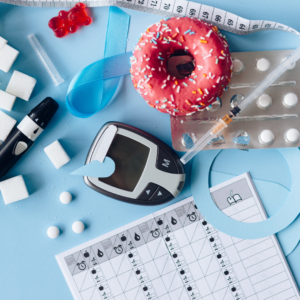 Believe it or not, it is now estimated that more than half of the U.S. adult population has diabetes or prediabetes.(1) With this trend continually increasing over the last few decades, America’s sugar high doesn’t seem to be crashing anytime soon. The good news? Diet, exercise, and vitamin support can have a powerful impact on your blood sugar.
Believe it or not, it is now estimated that more than half of the U.S. adult population has diabetes or prediabetes.(1) With this trend continually increasing over the last few decades, America’s sugar high doesn’t seem to be crashing anytime soon. The good news? Diet, exercise, and vitamin support can have a powerful impact on your blood sugar.
How do you get Diabetes?
Type 2 Diabetes is an insulin resistant diabetes that happens when insulin (the hormone that signals to your cells to take up glucose) no longer communicates well with the receptor. This results in the blood sugar staying in the blood stream rather than being used as energy by the cells, prompting a vicious cycle that stimulates even more insulin to get the response. Insulin comes from the pancreas, and after meeting this high demand for such a long time, the pancreas starts to cease insulin production and Type 2 Diabetes happens.(2) Type 1 Diabetes also results in insulin not being made by the pancreas, but is due to an autoimmune attack on the pancreas.
Testing for Diabetes
Three tests are used to assess prediabetes and Type 2 Diabetes: The Hemoglobin A1C (HgA1C), a fasting blood glucose, and a random (non-fasting) blood glucose.
- Hemoglobin A1C is basically a measurement of how glycosylated (sugared up) your red blood cells are. The life cycle of a red blood cell is roughly 120 days, so this estimate can give a long-standing look at blood sugar averages. It does not have to be fasting.
- 5.7-6.4 % – prediabetes
- 6.5 % or higher indicates diabetes
- A Fasting Blood Glucose is commonly measured after an overnight fast of 8-10 hours. Done through a Complete Metabolic Panel or even just a simple finger stick and glucometer reading, this measurement gives a glimpse about blood sugar regulation from the last 8-12 hours. Because of the longer timeframe, the HgA1C is often a preferred standard for an accurate picture. Fasting glucose can look normal for some, while the HgA1C is elevated. Both tests are nice to have when evaluating the full picture.
- Less than 70-100 mg/dL is normal
- Less than 70-95 mg/dL is optimal
- 100-125 mg/dL is Prediabetes
- 126 mg/dL or more on two separate occasions is diabetes
- The Random Blood Glucose is a non-fasting value, so the results will depend upon the last time you ate. Usually, blood glucose will be 130 mg/dL or lower after meals. This level decreases as time goes on, so it is good to track when the last meal or snack was consumed in relation to the random glucose. Regardless of when you ate, a blood sugar of 200 mg/dL or more suggests diabetes.
- Every so often the Oral Glucose Tolerance Test is used where a bolus of sugar is given and blood sugar levels are tested over two hours, but mainly this is saved during for screening for gestational diabetes in pregnancy.(3)
What Causes Insulin Resistance?
The answer to this question is still hotly debated. Insulin resistance correlates with obesity, especially deposition of abdominal or belly fat. We do see trends in families, suggesting genetics has a role as well. But, you do not have to be overweight to have insulin resistance. We know that various nutrients (such as chromium, biotin, and vanadium) help insulin on to the receptor, so we can surmise that these particular nutrient deficiencies play a role. Lack of exercise is also a common factor for developing insulin resistance.(4)
Standard American Diet or Standard American Stress?
Stress is another “backdoor” way our blood sugar gets elevated. Epinephrine, Norepinephrine (stress neurotransmitters) and cortisol (stress hormone) all prompt the liver to release stored glucose. You don’t even get to taste the sweetness, but your blood sugar is elevated all the same. Stress management is imperative for glucose control. Considering someone’s stress in addition to their diet is important—many people do have strict diets but if the A1C or blood glucose levels are not improving, stress is likely the missing key.
Can Blood Regulatory Diets Help?
Diets that decrease the amount of carb intake substantially improve prediabetes and diabetes outcomes. Low carb usually means eating less than 30-40 grams of carbs PER DAY. High carb sources include sweets, candy, breads, pastas, fruit, honey, agave, maple syrup, and grains like wheat, rice and corn. If you eat these things, portion control is essential.
The Standard American Diet is not just excessive in carb intake, but is also chemical-laden. Various preservatives, flavor enhancers, saturated fats, trans fats, and hydrogenated oils all have been found to increase insulin resistance.(5) Ever notice how your bread and cheese don’t really seem to mold? This is due to the additive propionate, and has been linked in studies to insulin resistance.(6) If you want to avoid or reverse insulin resistance, eat a diet full of whole, unprocessed foods and keep an eye on your carbs.
What About Exercise?
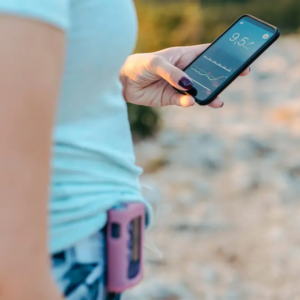 Even just 30 minutes a day of cardiovascular exercise has been shown to reduce insulin resistance. Now, this means your heart rate must come up. If you walk for exercise, add a few steep hills, stairs, or intervals of jogging, jumping jacks, squats or lunges. Increasing your heart rate is key to this process. Adding muscle also changes the entire metabolism of your body because it takes more energy to support muscles than fat cells. Higher muscle mass improves metabolism. Increased muscle mass through strength training will decrease your blood sugar.
Even just 30 minutes a day of cardiovascular exercise has been shown to reduce insulin resistance. Now, this means your heart rate must come up. If you walk for exercise, add a few steep hills, stairs, or intervals of jogging, jumping jacks, squats or lunges. Increasing your heart rate is key to this process. Adding muscle also changes the entire metabolism of your body because it takes more energy to support muscles than fat cells. Higher muscle mass improves metabolism. Increased muscle mass through strength training will decrease your blood sugar.
Supplement Support
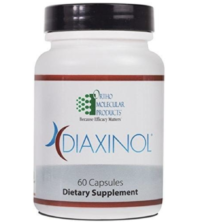 New habits pertaining to diet and exercise may take time to develop, so in the meantime supplementing with the vitamins, minerals, and herbs that help insulin dock to the receptor is usually a good idea. Chromium, biotin, vanadium, gymnema, and cinnamon are a few of my favorites. With strong insulin resistance, I’ve seen great results with Diaxinol by OrthoMolecular, a supplement that combines many of these previously mentioned vitamins and herbs in therapeutic doses.
New habits pertaining to diet and exercise may take time to develop, so in the meantime supplementing with the vitamins, minerals, and herbs that help insulin dock to the receptor is usually a good idea. Chromium, biotin, vanadium, gymnema, and cinnamon are a few of my favorites. With strong insulin resistance, I’ve seen great results with Diaxinol by OrthoMolecular, a supplement that combines many of these previously mentioned vitamins and herbs in therapeutic doses.
Berberine is an herb that actually slows glucose absorption off the bowel, making for a better steady-state blood sugar. It also improves the secretion of insulin from the pancreas. Berberine 500 by Integrative Therapeutics is one I commonly recommend, typically 500 mg 2 x per day.
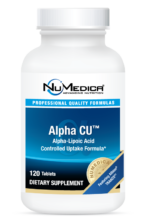 Alpha lipoic acid (ALA) is a very interesting nutrient that has surfaced in the last few years as a blood sugar regulator, among other things. ALA is a cofactor for the breakdown of glucose into energy, which is how it regulates blood sugar. In addition ALA is an antioxidant, a supporter of glutathione production (the major liver detox agent), and has been shown to improve diabetic neuropathy. (7) Due to its concentration and sustained release tablet, I usually recommend AlphaCU by NuMedica.
Alpha lipoic acid (ALA) is a very interesting nutrient that has surfaced in the last few years as a blood sugar regulator, among other things. ALA is a cofactor for the breakdown of glucose into energy, which is how it regulates blood sugar. In addition ALA is an antioxidant, a supporter of glutathione production (the major liver detox agent), and has been shown to improve diabetic neuropathy. (7) Due to its concentration and sustained release tablet, I usually recommend AlphaCU by NuMedica.
Asking someone to change their diet, exercise more, and handle their stress may sound like I’m basically suggesting changing everything about their life. This is absolutely overwhelming. Starting at the beginning of any change can be frustrating and even charged with fear. However, know that people do fix this. And they do so by making the changes they can.
It is not perfect all at once, but each day is a step forward. As long as you are making positive changes each day, soon, things will fall into place. And if changes are not fast enough, know that supplementation does help with the healing process. Do you need to take supplements forever? Absolutely not, but the habits and diet need to be solid to make that transition. Stay positive and know that reversing insulin resistance is possible!
If you have comments and/or questions about this blog, email us at blog@peoplesrx.com.
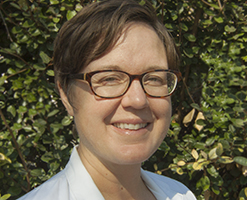
Amy Nelson, ND* received her Naturopathic Doctorate from the National College of Natural Medicine in Portland, OR where she studied nutrition, homeopathy, herbal and functional medicine. In addition, Dr. Nelson was the Associate at The IBS Treatment Center in Santa Monica where she treated irritable bowel syndrome and complex food allergies. Dr. Nelson utilizes her experience in natural medicine to address female and male hormonal imbalances, mental health, and digestive disorders. Amy is available for consultation at Peoples Lakeline.
*Although licensed in other states, Naturopathic Doctors are not currently licensed in Texas.
References:
- Menke A, Casagrande S, Geiss L, Cowie CC. Prevalence of and Trends in Diabetes Among Adults in the United States, 1988-2012. JAMA. 2015;314(10):1021–1029. doi:10.1001/jama.2015.10029.
- Schwartz MW, Porte D., Jr Diabetes, obesity and the brain. Science. 2005;307:375–379. doi: 10.1126/science.1104344.
- https://www.merckmanuals.com/professional/endocrine-and-metabolic-disorders/diabetes-mellitus-and-disorders-of-carbohydrate-metabolism/diabetes-mellitus-dm
- https://www.cdc.gov/diabetes/basics/insulin-resistance.html#:~:text=What%20Causes%20Insulin%20Resistance%3F,overweight%20to%20have%20insulin%20resistance.
- https://www.webmd.com/diabetes/diabetes-insulin-resistance-diet
- https://news.harvard.edu/gazette/story/2019/04/could-a-popular-food-ingredient-raise-the-risk-for-diabetes-and-obesity/
- Karalis DT, Karalis T, Karalis S, Kleisiari AS, Malakoudi F, Maimari KEV. The Effect of Alpha-Lipoic Acid on Diabetic Peripheral Neuropathy and the Upcoming Depressive Disorders of Type II Diabetics. Cureus. 2021 Jan 18;13(1):e12773. doi: 10.7759/cureus.12773. PMID: 33614362; PMCID: PMC7888960.
